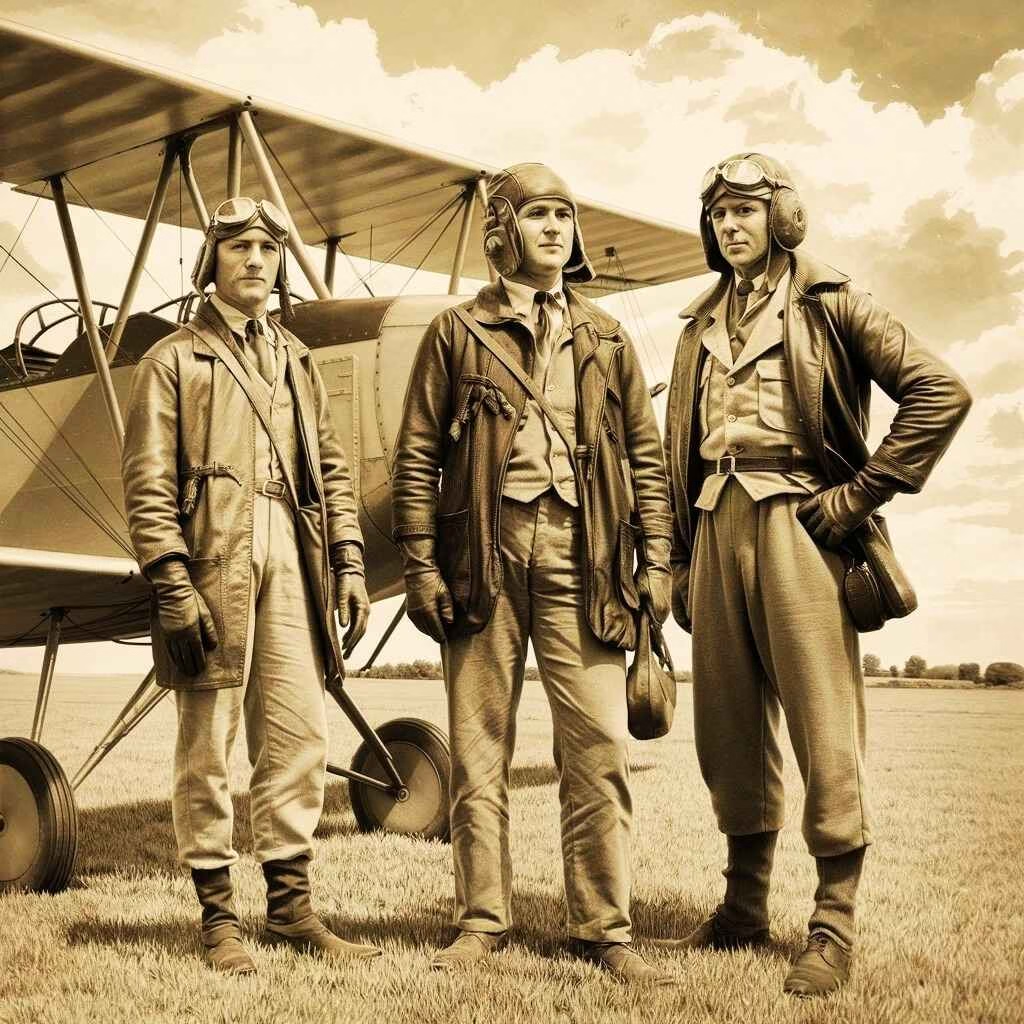Aviation uniforms have always symbolized professionalism, innovation, and style. Over the decades, these uniforms have transformed to meet the needs of changing times, blending functionality with fashion. In this article, we explore the fascinating evolution of aviation uniforms, from the rugged outfits of early pilots to the modern, sleek designs of today.
1. Early Aviation Days (1910s-1920s): Military Roots in Aviation Uniforms

At the dawn of aviation, pilots needed rugged uniforms to withstand harsh conditions. Inspired by military attire, early aviation uniforms were highly functional but lacked the polish of modern designs.
Key Features of Early Aviation Uniforms:
- Material: Thick leather jackets, gloves, and boots protected pilots from the freezing cold.
- Accessories: Goggles and helmets shielded them from wind and debris.
- Design: Practical, with no emphasis on style or branding.
During this time, aviation uniforms were about survival. Pilots operated in open cockpits, so their clothing had to prioritize warmth and durability.
2. The 1930s-1940s: The Birth of Elegance in Evolution of Aviation Uniforms

As commercial airlines emerged, aviation uniforms started to reflect professionalism. Airlines realized the importance of brand identity, and uniforms became tools to establish trust with passengers.
For Pilots:
- Airlines adopted designs inspired by naval officer uniforms. These included sharp jackets, peaked caps, and crisp white shirts.
- Uniforms featured epaulets to signify rank, adding an air of authority.
For Cabin Crew:
- Women became the face of in-flight hospitality, and their uniforms highlighted elegance.
- Airlines like Pan Am introduced stylish skirts, blouses, and accessories like gloves and hats.
This era marked a significant shift in the evolution of aviation uniforms. Airlines started using uniforms as a way to create a luxurious flying experience.
3. The Jet Age (1950s-1960s): Aviation Uniforms Embrace Fashion

The Jet Age revolutionized air travel, and aviation uniforms followed suit. Airlines began collaborating with fashion designers to create eye-catching and stylish uniforms.
Key Changes in Aviation Uniforms During the Jet Age:
- Bright Colors: Uniforms featured bold hues like red, blue, and yellow, reflecting the excitement of the era.
- Mini-Skirts: Cabin crew uniforms became shorter, embracing modern fashion trends.
- Designer Creations: Airlines partnered with designers like Emilio Pucci, who introduced vibrant patterns and futuristic styles.
Uniforms during this time showcased the glamorous side of air travel, emphasizing sophistication and trendiness.
4. The 1970s-1980s: Comfort and Experimentation in Aviation Uniforms

The 1970s brought cultural changes, and aviation uniforms adapted to reflect individuality and practicality. Airlines began exploring more relaxed styles without sacrificing professionalism.
How Aviation Uniforms Evolved in the 1970s-1980s:
- Materials: Polyester became a popular choice for its wrinkle-resistant and lightweight properties.
- Unisex Uniforms: Some airlines introduced gender-neutral designs, signaling a progressive shift.
- Accessories: Bright scarves and ties allowed for personalization while maintaining a cohesive look.
This period in the evolution of aviation uniforms focused on balancing creativity with comfort.
5. Modern Era (1990s-Present): Aviation Uniforms Redefined

Today, aviation uniforms blend tradition with innovation. Airlines prioritize inclusivity, sustainability, and practicality to align with modern values.
Modern Trends in Aviation Uniforms:
- Streamlined Designs: Tailored uniforms exude professionalism while ensuring comfort for long shifts.
- Gender Inclusivity: Airlines now offer crew members multiple uniform options, allowing them to choose what suits their style and identity.
- Sustainability: Eco-friendly fabrics made from recycled materials are becoming popular in aviation uniforms.
Modern aviation uniforms continue to evolve, embracing technology and sustainability while maintaining their iconic look.
6. Cultural Influence on Aviation Uniforms
The evolution of aviation uniforms has also been shaped by regional and cultural influences:
- Asian Airlines: Uniforms often incorporate traditional attire, like the cheongsam or saree, creating a unique blend of heritage and modernity.
- Middle Eastern Airlines: These uniforms are known for their modest yet luxurious designs, often reflecting the elegance of their brand.
Cultural elements make aviation uniforms a global symbol of respect and diversity.
7. Technology in Aviation Uniforms: Shaping the Future
Advancements in fabric and design technology have driven the evolution of aviation uniforms.
- Fire-Resistant Fabrics: Modern uniforms ensure crew safety during emergencies.
- Stretchable Materials: These improve mobility, ensuring comfort during demanding workdays.
- Smart Technology: Some airlines are testing uniforms with RFID tags and temperature-regulating fabrics.
Technology is not just making aviation uniforms safer but also more functional and comfortable.
8. The Future of Aviation Uniforms

The evolution of aviation uniforms is far from over. Future trends are likely to include:
- Sustainable Practices: Airlines may adopt fully biodegradable uniforms to reduce environmental impact.
- Personalized Designs: Uniforms could be customized for better fit and comfort using advanced design tools.
- Tech-Integrated Uniforms: Innovations like built-in health monitors and communication tools could become standard features.
The future of aviation uniforms will combine style, technology, and eco-consciousness.
Finally, the evolution of aviation uniforms tells a fascinating story of how the aviation industry has adapted to societal changes, technological advancements, and passenger expectations. From practical leather gear to modern eco-friendly designs, aviation uniforms have consistently balanced function and fashion.
As airlines continue to innovate, aviation uniforms will remain a vital part of their identity, reflecting the journey of aviation itself.



